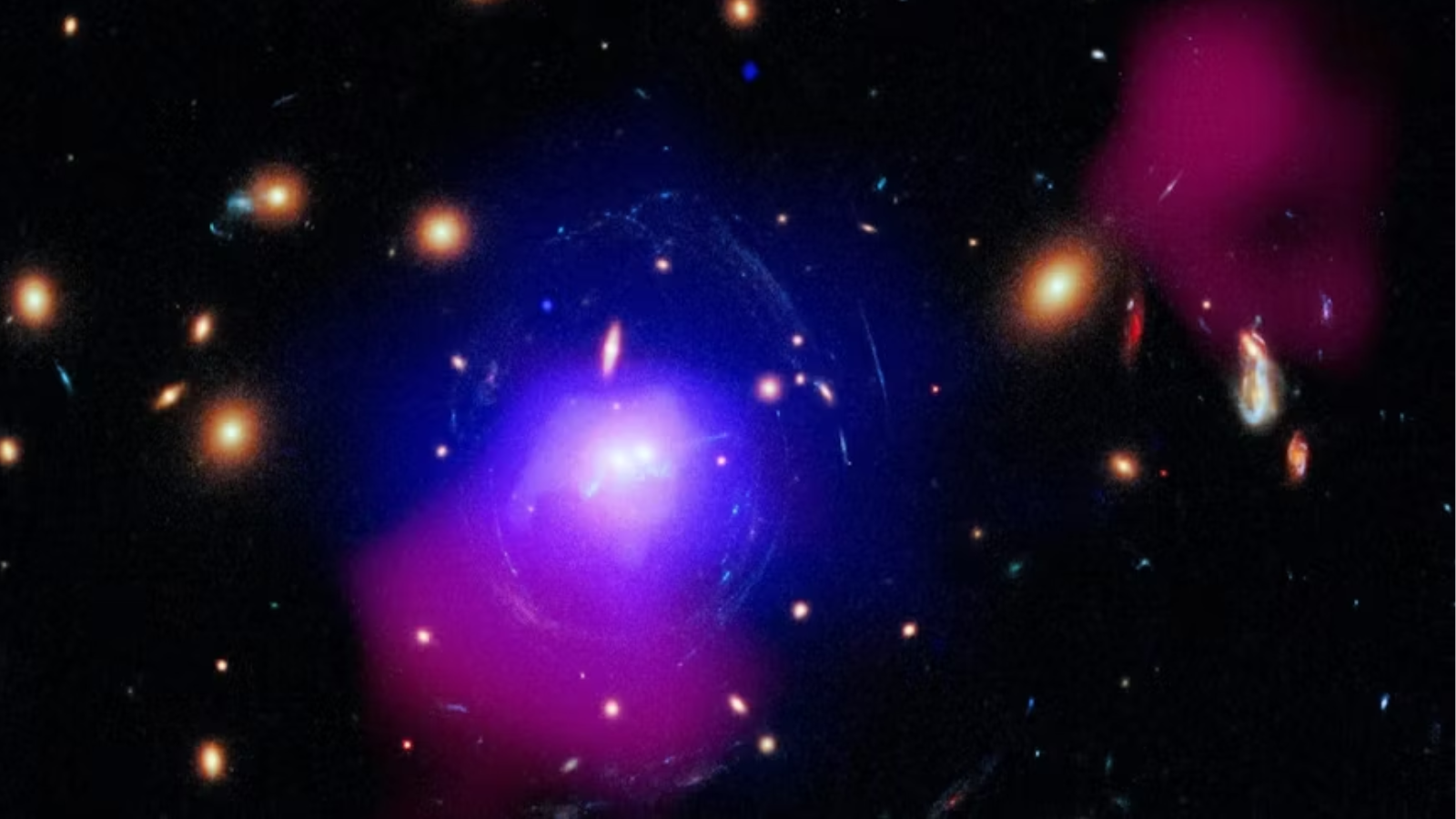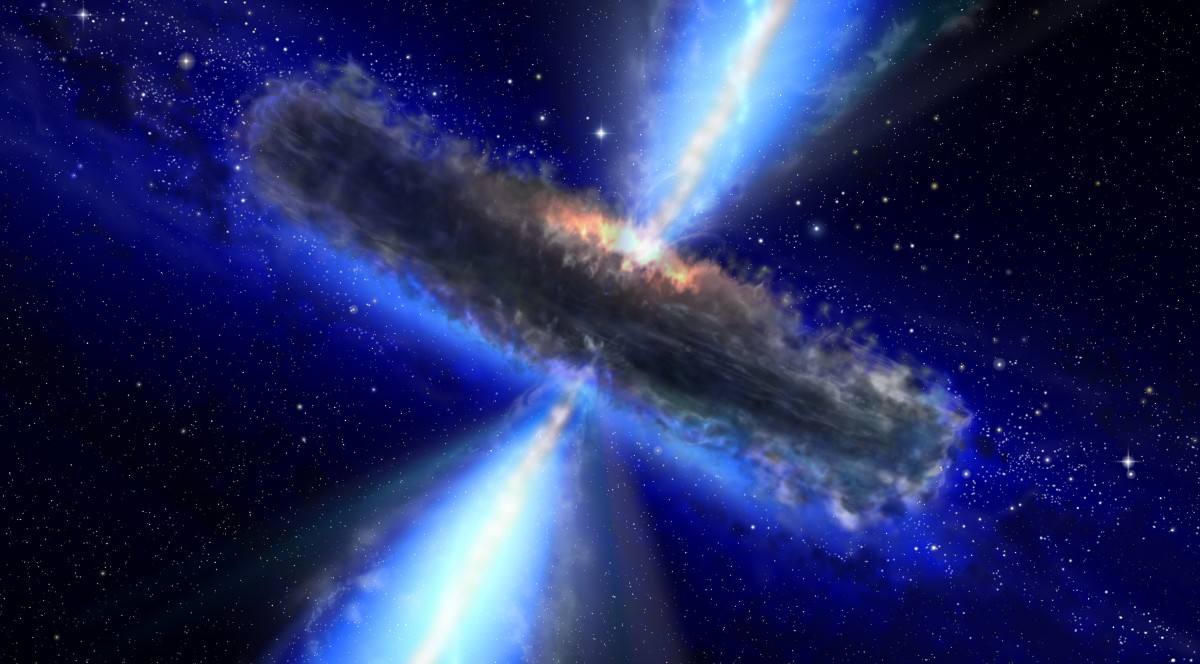Black hole's powerful eruption creates a string of stellar jewelry
The massive outburst emitted 100,000 trillion times more energy than the sun will over its entire lifetime.

Astronomers have discovered one of the most powerful black hole eruptions ever seen — and this immense explosion, which occurred almost 4 billion years ago, formed a pattern of stars in clusters that resemble jewelry.
The starry necklace adorns a massive cluster made of hundreds of galaxies called SDSS J1531; this body is located some 3.8 billion light-years from Earth. The galaxy cluster also hosts a vast reservoir of hot gas, and at its heart, two of its largest galaxies are in the process of merging into one. The eruption scientists picked up on likely originated from the supermassive black hole in one of those colliding galaxies.
And as these galaxies continue their trajectory toward smashing together, scientists were able to make out an S-shaped string of 19 huge star clusters called "superclusters."
To investigate the formation of the supercluster string, astronomers from across the globe turned to a wealth of data associated with the electromagnetic spectrum, including radio wave data from the Low-Frequency Array (LOFAR) radio telescope, and visible light and X-ray data collected by NASA's Chandra X-ray Observatory. Understanding the formation of this incredible feature could result in a better picture of how supermassive black holes shape the environments around them.
"Black hole eruptions, like the one that helped create the superclusters in SDSS J1531, are predicted to be very important in keeping the gas in galaxy clusters hot," Timothy Davis, member of the research team and a scientist at the University of Cardiff, said in a statement. "Finding such clear evidence of this ongoing process allows us to understand the impact of monster black holes on their environments."
Related: Brightest quasar ever seen is powered by black hole that eats a 'sun a day'
Unlikely celestial jewelers
Supermassive black holes with masses millions, or even billions, of times that of the sun are believed to dwell at the hearts of all large galaxies.
Get the Space.com Newsletter
Breaking space news, the latest updates on rocket launches, skywatching events and more!
While many of these cosmic monsters lurk quietly, such as Sagittarius A* (Sgr A*) that sits at the heart of the Milky Way, others voraciously feed on gas, dust and even stars around them. These supermassive black holes are part of what're known as in active galactic nuclei (AGN), and are surrounded by disks of gas and dust that feed them. Those disks are called accretion disks. The massive gravitational influences of these actively feeding black holes create turbulent conditions in their respective accretion disks, causes the environment to glow brightly.
Additionally, any matter that doesn't fall into the supermassive black hole gets channeled to the poles of the cosmic titan by powerful magnetic fields. Here, these charged particles are accelerated to speeds approaching that of light, erupting as highly-collimated relativistic jets from both poles of the black hole. This eruption is typically accompanied by a blast of electromagnetic radiation across a range of wavelengths of light.
As a result, AGNs and the quasars associated with them are often so bright they outshine the combined light of every star in the galaxies around them.

As the jet that erupts from one of the giant galaxies at the heart of SDSS J1531 pushes outwards, the team says it plows hot gas away from the black hole. The team behind this research thinks such activity created a giant cavity around the void.
"We are already looking at this system as it existed four billion years ago, not long after the Earth formed," team leader and Harvard Center for Astrophysics researcher Osase Omoruyi said in the statement. "This ancient cavity, a fossil of the black hole, tells us about a key event that happened nearly 200 million years earlier in the cluster’s history."
In reconstructing this violent sequence of events with Chandra, Omoruyi and colleagues tracked movements of the dense gas near SDSS J1531's heart. This revealed bright X-ray "wings" at the edge of the cavity. Radio wave data from LOFAR revealed to the team the remnants of energetic particles connected to the erupted jet, the "smoking gun" evidence of this ancient, powerful eruption.
"This system clearly has a very active black hole, which repeatedly erupts and is strongly affecting the gas around it," Davis said. "Here, we detect the smoking gun and see its impact all at once."
The energy of this jet's outburst is one of the highest ever recorded, Omoruyi explained in a blog for Harvard that the jet released 100,000 trillion times more energy than the sun will over its entire lifetime.
"As the jet propagated through space, it carved out a giant bubble in the cooling gas, uplifting and dispersing the surrounding material," she continued. "Despite occurring almost 200 million years ago, the legacy of the outburst endures. The previously uplifted gas has now cooled and is gravitating back towards the center of the cluster, and provided the fresh fuel for the young 'beads on a string' star formation."
Omoruyi added that while the discovery of this powerful outflow was surprising in itself, one of the most remarkable things about this observation is the fact that the overall cluster has remained stable.
What the team has yet to discover is evidence of the the second powerful jet that would have erupted in the opposite direction and from the other pole of the supermassive black hole. The researchers think evidence for this jet twin could be found in X-ray and radio wave emissions with further investigation.
"We think our evidence for this huge eruption is strong, but more observations with Chandra and LOFAR would clinch the case," Omoruyi concluded. "We hope to learn more about the origin of the cavity we've already detected and find the one expected on the other side of the black hole."
The team's research is published on the paper repository arXiv and has been accepted for publication in the Astrophysical Journal.
Join our Space Forums to keep talking space on the latest missions, night sky and more! And if you have a news tip, correction or comment, let us know at: community@space.com.

Robert Lea is a science journalist in the U.K. whose articles have been published in Physics World, New Scientist, Astronomy Magazine, All About Space, Newsweek and ZME Science. He also writes about science communication for Elsevier and the European Journal of Physics. Rob holds a bachelor of science degree in physics and astronomy from the U.K.’s Open University. Follow him on Twitter @sciencef1rst.









